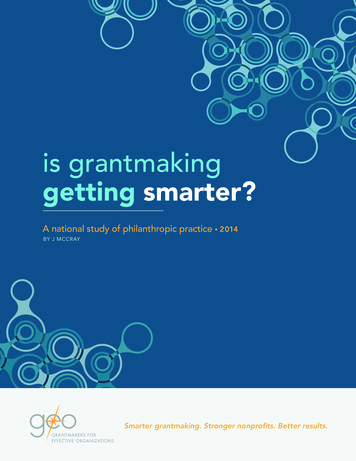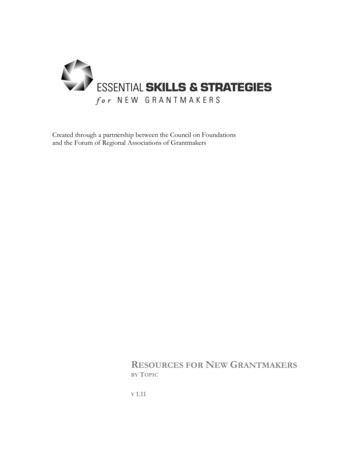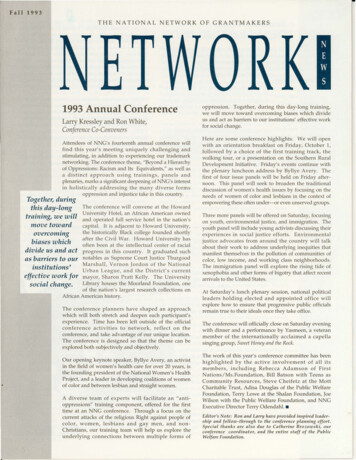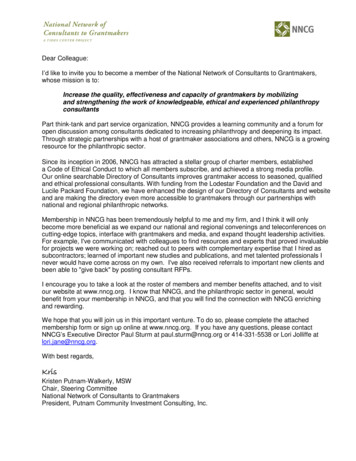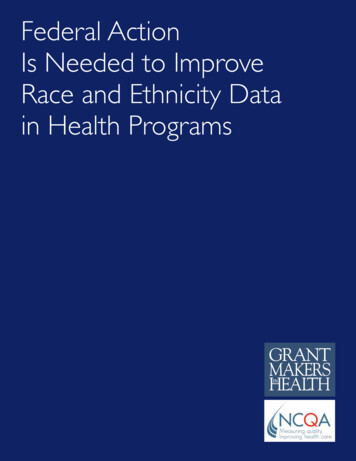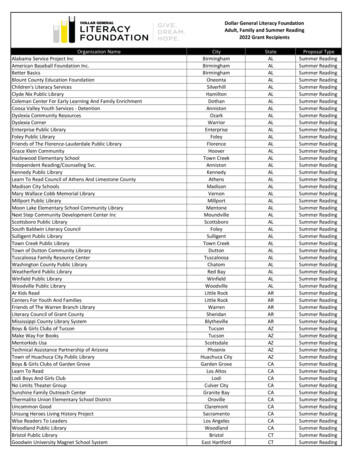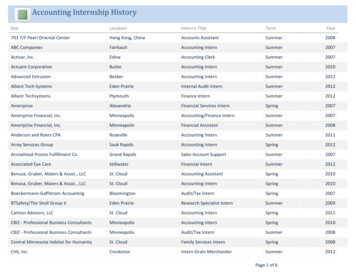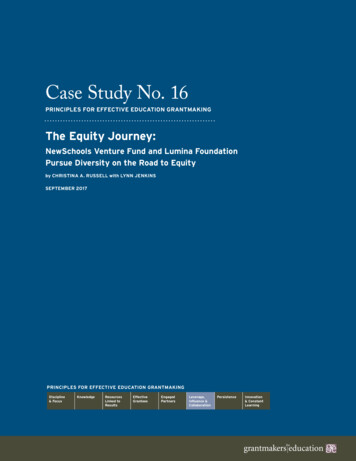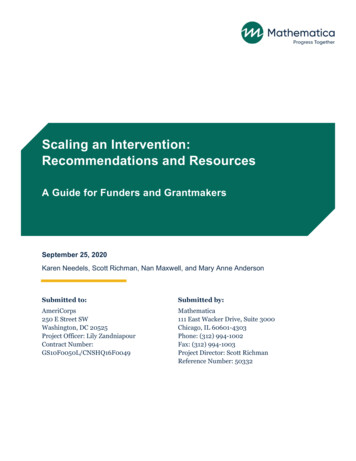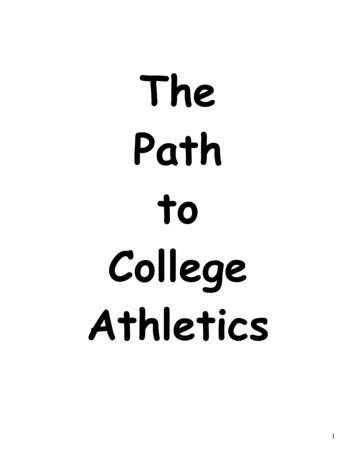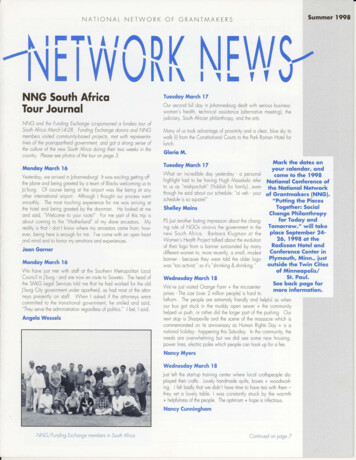
Transcription
Summer 1998NATIONAL NETWORK OF GRANTMAKERSNNG South AfricaTour JournalNNG and the Funding Exchange co-sponsored a funders tour ofSouth Africa March /4-28 Funding Exchange donors and NNGmembers visited community-based proiects, met with representatives of the post-apartheid government, and got a strong sense ofthe culture of the new South Africa during their two weeks in thecountry Please see photos of the tour on page 3.Monday March 16Yesterday, we arrived in Johannesburg l It was exciting getting offthe plane and being greeted by a team of Blacks welcoming us toJo'burg. Of course being at the airport was like being at anyother international airport. Although I thought our process wentsmoothly The most touching experience for me was arriving atthe hotel and being greeted by the doorman. He looked at meand said, "Welcome to your rootsl" For me part of this trip isabout coming to the "Motherland" of my slave ancestors. Myreality is that I don't know where my ancestors came from; however, being here is enough for me I've come with an open heartand mind and to honor my emotions and experiences.Joan GarnerMonday March 16We have lust met with staff at the Southern Metropolitan LocalCouncil in j'burg - and are now en route to Soweto The head ofthe SMLG Legal Services told me that he had worked for the oldj'burg City government under apartheid, as had most of the attorneys presently on staff. When I asked if the attorneys werecommitted to the transitional government, he smiled and said,"They serve the administration regardless of politics." I bet, I saidAngela WesselsTuesday March 17Our second full day in Johannesburg dealt with serious business:women's health, technical assistance (alternative meeting), thejudiciary, South African philanthropy, and the arts.Many of us took advantage of proximity and a clear, blue sky towalk III from the Constitutional Courts to the Park Roman Hotel forlunch.Gloria M.Tuesday March 17What an incredible day yesterday - a personalhighlight had to be having Hugh Masakela referto us as "mishpochah" (Yiddish for family) eventhough he said about our schedule "oi veh - yourschedule is so square I"Shelley MainsPS Just another lasting impression about the changing role of NGOs vis-a-vis the government in thenew South Africa. Barbara Klugman at theWomen's Health Proiect talked about the evolutionof their logo from a banner surrounded by manydifferent women to, more recently, a small, modestbanner - because they were told the older logowas "too activist," so it's "shrinking &shrinking."Wednesday March 18Mark the dates onyour calendar, andcome to the 1998National Conference ofthe National Networkof Grantmakers (NNG)."Putting the PiecesTogether: SocialChange Philanthropyfor Today andTomorrow," will takeplace September 2426, 1998 at theRadisson Hotel andConference Center inPlymouth, Minn., justoutside the Twin Citiesof Minneapolis/St. Paul.See back page formore information.We've just visited Orange Farm the microenterprises - The size (over 2 million people) is hard tofathom The people are extremely friendly and helpful as whenour bus got stuck in the muddy open sewerthe communityhelped us push, or rather did the larger part of the pushing. Ournext stop is Sharpeville and the scene of the massacre which iscommemorated on its anniversary as Human Rights Day is anational holiday - happening this Saturday. In the community, theneeds are overwhelming but we did see some new hOUSing,power lines, electric poles which people can hook up for a fee. Nancy MyersWednesday March 18Just left the start-up training center where local craftspeople displayed their crafts. Lovely handmade qUilts, boxes woodworking I felt badly that we didn't have time to have tea with them they set a lovely table , was constantly struck by the warmth helpfulness of the people The optimism hope is infectious.Nancy CunninghamNNG/Funding Exchange members in South AfricaContinued on page 7
Letter from the Acting Executive DirectorBy Joan P. GarnerGreetings l It's been over a year since I joined the staff of the National Network of Grantmakers as Associate Director, and a lot hashappened in such a short period It gives me pleasure to share this newsletter with you, which highlights our recent tour to SouthAfrica, March 14-28. The tour was co-sponsored with the Funding Exchange, and proved to be educational, exhilarating, adventurous, resourceful, and fun. I'm grateful to those who lourneyed with us and made contributions to this issue. Also featured is an articleby Cora Weiss, President of the Samuel Rubin Foundation, who also made a recent iourney to South Africa.As a brief sidebar, many of you know that Terry Odendahl, NNG's Executive Director, began a well-deserved sabbatical April 6, andwill return to work July 6, 1998 We wish her well. As Acting Executive Director until July, I will continue to work from my office inAtlanta. Gerard Holmes and Abby Polin are holding down the San Diego office during this time I encourage you to attend severalupcoming NNG conferences the Donor Organizers Network (DON) conference will be held July 22-24 in San Diego, and theNational Conference September 24-26 in Plymouth, Minnesota (outside Minneapolis/St. PaullThis trip to South Africa was reflective of the values of NNG in the commitment to move more money into social and economic justiceissues and as a collaboration with FEX. Mary Tiseo of South Africa Partners worked with Marcia Gallo of FEX and me to help planand coordinate our tour. Sharon Gelman of Artists for a New South Africa assisted Mary with on site visits and logistics Because oftheir experience in South Africa, our tour was enriched with a fomiliarily that is often lost when traveling to a distant placeIn planning the tour, both Marcia and I wanted it to reflect NNG and FEX values. We didn't want just another tour, so FundingExchange asked its members to each donate 5,000 to a grantmaking pool that would be awarded immediately to groups we visited. A total of 65,000 was contributed NNG asked its members to provide assistance to groups seeking additional funding, andto act as contacts back in the States, to make referrals after the trip.There were 27 people in our delegation We were a diverse group, comprised of individual donors, representatives of fundinginstitutions and affiliated groups, and anti-apartheid activists and supporters.It would be difficult to capture here the true essence and complexily of South Africa and what I learned and felt throughout my visit.In many ways, it was a bittersweet experience. There are millions of Blacks living on barren land in shanlytowns with little or no running water or electricily. Unemployment is high, as is crime and domestic violence, and the budget for education has been slashed,eliminating some 400 teachers. These are just a few of the lingering effects of apartheid. Yet, we met with so many people, fromcommunily organizers to public officials, who seem hopeful for a new sociely. Most realize that 400 years of apartheid will not beeradicated overnight. Our delegation was welcomed and treated as dignitaries everywhere we traveledOur schedule was packed. We visited more than forly-five communily projects, non-governmental (nonprofit) organizations and culturalgroups. The itinerary included visits to Johannesburg, East London, Port Elizabeth, and Cape TownWe spent several days in Johannesburg and visited several surrounding townships, including Sharpeville, where a massacre occurredin the 1960s killing sixlynine Africans and wounding more than four hundred people. Most impressive was our meeting with theyoung dynamic Black woman Mayor of Soweto She described the progress that has been made since 1994, ranging from job andskill training to counter the 30 percent unemployment, to the 18 percent growth of women in the Cily Council. People are taking holdof their communities and making positive changes.Visiting the Eastern Cape was one of my favorite parts of the trip. Surrounded by vast mountainsides and valleys, hundreds of townships sprinkled the countryside We visited the renowned Fort Hare Universily in Alice, where Nelson Mandela and other Africanleaders were educated. There we toured the African National Congress (ANC) archives and met with a women's micro-enterprise proiect. Later we visited the grave of Steven Biko. Here in the Eastern Cape, we also met with the Eastern Cape NGO Coalition, whichwas formed in 1995 to represent the Northeast, Central, and Middle regions of the province. Its primary aims are to foster involvement in policy and development plans, build the capacily of its membership, and share information among members.Cape Town was stunning, nestled in the shadows of Table Mountain. Most memorable was the morning we spent touring RobbenIsland with Ahmed Kathrada, an ex-political prisoner who spend eighteen years in prison with Nelson Mandela It was an honor tospend time with Mr Kathrada, an extraordinary person While visiting several neighboring townships, we met with Ilitha Labantu, adomestic violence program in Guguletu Township and a grantee of Public Welfare Foundation. The group offers counseling supportgroups and emergency shelter for abused women and their children. Also while in Cape Town, our delegation had an opportunily tomeet with US Ambassador James Joseph.The issues facing South Africa are in many ways similar to the issues facing us in the United States and other countries around theworld And yes, our local issues have an impact on the global economy. South Africa is at the forefront of creating change I knowthat many of you already support the work going on in South Africa, and I urge you to continue. "Freedom has always been anexpensive thing," said Dr. Martin Luther King, Jr We cannot afford to ignore South Africa at this time in history. Their struggles mirrorour struggles and we can learn from their progress.2
3
Interview withDonor/NNG BoardMember Alan Rabinowitzand Great Society programs, on the one hand, and anti-Vietnamprotests, on the other. The Tax Act of 1969 was the first to defineby Isabel Olivera-Moralesof their assets to philanthropic causes.Born in New York City, NNG board member Alan Rabinowitzsays he came to consciousness during the New Deal His attitudes were initially shaped by his parents and institutions like the"progressive" Lincoln School of Columbia University's TeachersCollege, which he attended as a child. His mother came from afamily of Illinois Republicans, but she was a Democrat Her familywas well-to-do in the 1890s but had lost all their money by Worldthe difference between private and public foundations and to prohibit the locking up of productive assets in foundations. The TaxAct of 1969 distinguished between what was tax-exempt andwhat wasn't, and foundations were required to give at least 5%The 1970s saw the growth of public foundations like the YouthProject, the foundations that created the Funding Exchange, andthe Northwest's A Territory Resource, which Alan and Andreaioined in 1979, a year after it was foundedWhen they joined,there were about 10 donors; today there are 200Alan was thefounding chairperson of the Western States Center Alan andAndrea are also members of the Threshold Foundation. In addi-War I. His father, a Republican, immigrated to New York's Lowertion, he sits on the board of Cascadia Revolving Fund, a leadingEast Side from the Ukraine in 1884 and was mentored by LillianD. Wald, a social reformer and founder of the Henry StreetSettlement House and the Visiting Nurse Service.community economic development fund for women and people ofAlan's education included a BA from Yale, an M.BA fromHarvard, and, many years later, a Ph.D.in city and regional planning from MIT. His career includes being a navy officer in the early1950s, working in finance, real estate, and economic development consulting during the 1950s and 1960s Eventually, in1971, he loined the faculty of the University of Washington,where he stayed for 15 years, teaching housing and state-localfinance. In 1986, he gave up his professorship and has spent histime in community economic development consulting, in writing,and in exploring the world of "social change philanthropy."Alan and his wife Andrea, a child therapist and expert in the education of young children, have been married since 1951, despiteher reluctance to marry someone in high finance "You have to liveand do what you really believe in," she said. Andrea's Quakerheritage and belief in social justice have been important to theirmutual interest in working with (and helping fund) community organizations working to empower low-income and minority groups.Their philanthropic activism dates back to the 1950s, but he wasnever able to convince the board of his father's not-very-big foun-color going into business for themselves, and is a major fundraiser for the Washington State Chapter of the ACLUSince the late1980s, Alan has served as chief advisor for the Pequod Fund ofthe Tides Foundation, and as a trustee of a small family foundation (operated in the company of his Wife, four children, theirspouses and offspring) with a focus on children, health, andenvironmental justice.Alan joined NNG in 1986 and served as its treasurer from1989-1996He co-chaired the Strategic Planning Committee ofNNG with Miyoko Oshima in 1996, which has set the coursefor the next five years of NNG, with the thrust of moving moneyto social change. He is currently on the Board and chair of theNNG's new Action Research Committee. In 1990, encouragedby David Hunter, Executive Director of the Stern Fund, Alan wroteSocial Change Philanthropy in America, the first systematic lookat the organizations and people who had been inspired by thelikes of David Hunter and byRobin Hood Was RightAlan con-tinues to encourage people's interest in progressive philanthropy,saying and writing such things as, "There should be more socialchange giving . there is lots of work to be done. grantees andfunders should be able to work and communicate togetherdation to fund such organizations.foundations should be able to communicate with each other morefreely. people should work together to create a community ofThe world of philanthropy changed dramatically in the late 1960s,partly as a result of the activism that swirled around the civil rightswhere people enjoy being in this field and can learn to be effective voices for social change philanthropy"progressive funders, " and lastly, "NNG should be the place-Attention! Come to a Great Conference!The Donor Organizers' Network's Reaching Out to New Donors for a Just, Caring, and Sustainable Future: HighTech, Donors of Color, Lesbian and Gay, and Youth, will be held July 22 -July 24, 1998 at the Island Palms Hotel &Marina, San Diego, CAThe purpose of this conference is to learn how to help empower donors to become allies in the larger goal of creating a just, caring,and sustainable futureWe will focus particularly on four constituencies (all with tremendous variations among them) including donorsfrom the world of high technology, donors of color, young donors, and gay and lesbian donorsThe aim is for donor activists, donororganizers, development and executive directors to learn from one another about how to raise consciousness and increase activismamong people with wealthWorkshops include:1. Developing Strategic Giving Plans2. Donor Advised Funds and Donor Circles3. Exploring the Emotional Dimensions of Doing Donor OrganizingRegistration is 350 For more information please call DON Coordinator, Jennifer Ladd, at 413-585-9709 or e-mail her atjladd@igc.org. To register, send a check for 350 to NNG with the memo DON conferenceSpace is limited to 50DON aimsto serve and increase the number of people and organizations helping individuals with wealth become partners in progressive socialchange through increased giving, volunteerism, and activism.4
Giving Globally IsHelping Locallyby Cora Weiss, PresidentSamuel Rubin FoundationThe scene was a church basement on Smoll Street Moll, or"muggers capitol." It was, by President Mandela's own reckoning, the most violent street in Johannesburg. The children,from ages 2-6, were in nursery school and the subject wasguns. Joseph Dube hod been working with the stoff to developa program on gun consciousness. The children drew picturesof guns and one by one they stood up and told the story oftheir drawing. They have all heard gunshots, some have seenfamily or friends gunned down, others have known their father'scar was hijacked. Violence and guns were port of their shorthistories and they were now engaged in declaring their nurseryschool a gun-free zone. They wore little stickers with "GunFree" pointed on them, taking the issue home with them. Whatif Jonesboro, Ark, schools hod gun-free lessons 2Dube also holds workshops with teenagers and has developeda "buy-bock" program where kids "sell" their guns, but themoney is given to their community development program andthe teen is invited to sit on the decision-making committee.Might that technique work in our inner cities?Gun Free South Africa is one of the grantees of the SamuelRubin Foundation that we visited during a two-week trip whichalso brought us together at a roundtable discussion sponsoredby the New Englond Circle on child soldiers with GracoMochel and her partner, Madiba Mandela.International grantmaking levels are up, according to a studyof US foundation trends from 1990-94. But the study is soold, by today's high-tech standards, that it really doesn't tellthe whole current story With the extraordinary rise in the stockmarket, with so many new funders on the scene, with greatertravel to countries in transition, and with less anxiety aboutgiving directly, I would imagine, without doing a scientificstudy, that the 1998 picture is even better.The Foundation Center study, in cooperation with the Councilon Foundations, highlights giving by the largest foundations,which have traditionally put money into supporting emergingcivil society abroad, educational and cultural institutions.The study serves to demythicize grantmaking abroad, showingthe various ways it can be done. 821 foundations giving 10,000 or more to overseas recipients (which may meangrantees in the US doing work abroad) were studiedInternational grants represent about 115% of all giving byfoundations, up 18% since 1990, a total of nearly 680million, with a majority of funding going to Latin America, b tthat was 1994 Why it took so long to be reported, we don tknow. Those queried were the largest foundations Theincrease matched the growth rate for all funding.Prediction of future trends indicates that funding for internationalprograms will either remain the some or increase, with midsized and smaller funders expressing increased interestbecause of "increasing interdependence and declining differentiation between 'domestic' and 'international' issues." Areas ofinterest include support for civil society, for reproductive health,education, security, ethnic conflict resolution, and philanthropicorganizing. To order International Grantmaking A Repor on USFoundation Trends, contact The Foundation Center, 79 Fifth Ave,New York, NY 10003-3075, or 1-800-424-9836 50,plus 4.50 for shipping.Find it on the Web athttp://fdncenter.org/bookWhy should progressive funders consider grantmaking abroad?Look around you. What ore you wearing, where was It made 2Where was your TV, VCR, watch, laptop, or microwave made 2What happened to your stock portfoliO when the Asian marketcrashed2 What happened to the whole world when the Berlin wallwas pushed down and the cold war ended? Our shrinking planet isspinning with all of us on board, and the rivers that dry up m onecountry, or the strife that breaks out in another, or the unemploymentand poverty in a third, all impact on neighboring countries. Wedon't live alone, and increasingly we depend on and appreciateinternational agencies and organizations, including the UnitedNotions, to help keep order and prevent conflict.Gun buy-bock programs haven't worked in Ihis country, but perhapsthe ideas brought bock from South Africa might be applied here.Perhaps we can learn from our neighbors.From May 11-16, 1999, there will be on end of the century conference to consider the abolition of war and the launch of a culture ofpeace for the next century The Hogue Appeal for Peace will attract10,000 people from around the world to consider the root causes ofwar, disarmament, humanitarian lows and institutions, and conflictprevention and resolution, so that we might live in the 21st Centurywith a new way of thinking and doing. After all, how did slavery,colonialism, and apartheid become delegitimized and ultimatelylargely erased from society2 The conference in The Hogue requiresfunding both in the US to organize and mobilize people here, especially youth, and funding abroad to enable people from developmgcountries to come to The Hogue, so that on returning home, poliCieswill be impacted on the local, notional, and regional levelssimultaneously around the world Who would soy no to the endof war? For further information: Hogue Appeal for Peace,777 UN Plaza, New York, NY 10017, fox 212-599-1332,e-mail hap99@igc.apc.org . Mapping a Path forEvaluationEvaluation - funders wont it, stoff need it, and programs deserveit. Yet, for many nonprofits, especially newer and smaller agencies, knowing where to begin can be difficult. Newly availablefrom Girl's Best Friend Foundation in Chicago, is Mapping a Pathfor Evaluation, a practical, easy-to-use planning guide whichdemystifies evaluation and offers simple, step-by-step guidanceProduced by Girl's Best Friend Foundation in collaboration withthe University of Illinois' Center for Research on Women andGender, this 32-page, down-to-earth booklet uses the evaluationof programs for girls to layout the basic principles, practices, andbenefits of evaluation to any nonprofit organization.To order at 12/copy (discounts for multiple copies),call Girl's Best Friend Foundation at 312-266-2842,or e-mail gbf@ix.netcomcom5
Donor Thank You/sMembership dues make up only 7% of NNG's budget. The financial support of individual members and grantmaking organizationsmake it possible for NNG land the Donor Organizers Network, orDON) to meet its strategic gools. At its january meeting, for example, NNG's board of directors pledged more than 12,000 incontributions.Foundations assist NNG through grants and as SupportingInstitutions NNG's 41 Supporting Institutions provide at least 1000 per year in financial support and publicly endorse the visionand mission of NNG. We would like to thank all of those whosupport NNG.NNG supporters include:Angelica FoundationAspen Institute Nonprofit Sector Research Fundjames BabsonAdriana BollenBen &jerry's FoundationOtto Bremer FoundationKaren ByrneCS FundCalifornia Well ness FoundationCaritas Fund lof the Tides Foundation)Robin CartonSteve CheifetzChicago Resource CenterSusan B. CollinsHarriet DenisonRichard H. Driehaus FoundationMarta DruryFACT Services Company, Inc.Diane FeeneyMarjorie Finejohn Foster-BeyFoundation for a Compassionate SocietyFoundation for the Mid-SouthFund of the Four DirectionsFunding ExchangeEllen FurnariDebra Furryjoan P GarnerTracy GaryGerbode FoundationGill FoundationGirl's Best Friend Foundationjoseph GotkowitzHKH FoundationPhilip HallenEdward W. Hazen FoundationHispanic FederationMatt HoweAlice ItoBetty KapetanakisPeter KentMelissa Kohner6Larry Kressleyjennifer LaddRebecca LiebmanArthur and Susan Lloydjohn D. and Catherine 1 MacArthur FoundationRichard MagatDoug MalcolmMcKay FoundationBarbara MeyerBert and Mary Meyer FoundationMinneapolis Community FoundationCarol MollnerCharles Stewart Mott FoundationStewart R. Mott Charitable TrustKenneth MountcastleMs Foundation for WomenGael Murphy and Laurie EmrichNeedmor FundNew World FoundationNokomis FoundationNorman FoundationNorthwest Area Foundationjessie Smith Noyes FoundatoinTeresa OdendahlIsabel Olivera-MoralesDavid and Lucile Packard FoundationCarol PenckePequod Fund lof the Tides Foundation)Phyllis Wendt PiercePohaku Fund (of the Tides Foundation)Public Welfare FoundationAlan RabinowitzAndrea RabinowitzAndy RobinsonWinthrop Rockefeller FoundationMurray RosenblithSamuel Rubin FoundationShaler Adams FoundationAileen ShawSister FundRalph L Smith FoundationSolidago FoundationLuis SolisDaniel SolomonAbbot StranahanSarah StranahanF Morgan TaylorTides FoundationTurner FoundationUnitarian Universalist Veatch Program at Shelter Rockjennifer WarburgIngrid WashinawatokMarc N. Weiss and Nancy MeyerAlbert B. and Susan M. WellsWieboldt FoundationRonald Whitejoseph Wilson
South Africa Tour journal . . Continued from Page IWednesday March 18How reassuring to see that the gay lesbian communily in thetownship is so well organized· a highlight was being "whisked"from the backyard patio into the house as food drink wererelocated hastily due to the Zulu wind which is rumored to blowfrom the dead warning everyone not to be outside IMary PowersThursday March 19Afterglow from the incredible convivialily of last evening spentwith gay, lesbian, bi, trans, and friends in Kwathema. About25 of them cooking sausages, chicken, fish, beef on a grill,greeting us, shoring in their activism. What a feast offriendship Iappeared to be a very large garage· cement floor and barrenwalls. But it had been transformed by our hosts and their friendsinto a room filled with music and dancing by young people (whoentertained us all eveningl and buffet tables full of traditionalAfrican food There was an even longer table full of Xhosa craftsavailable for purchase We were welcomed by the local politi·cians and their families and treated like Iong·lost friends. It wasdifficult to leave such good company. I heard myself, time aftertime, inviting our new friends to come to the US and allow us toreturn their hospitalily. But, in fact, I'm not sure that we couldever match the warmth and the welcome extended to us by ournew friendsAlice SenturiaTuesday March 24Beginnings of 3 separate poems written in the nightI am missing my childrenSearching within myselfWe are here in South AfricaBut could be homeThe ocean is poundingWe are strangersWe washed our hands and all ate with our fingers as we got toknow our world family. With a "mailing list" of 200 members,the LGBT township members have coalesced into a diverse, sup·portive, activist group. They shared their histories of activism,their goals for the attainment of their civil rights, and amazed uswith the real power of a dedicated few. We learned a lot.Addresses were exchanged and bridges built amidst our shareddreams of equal civil rights for allDisconnectedTired of being toldHow to be rightWrong againWe are hereDisconnectedDisaffectedPolitically CorrectStrangersKate O'HanlonFriday March 20We had a brief but moving tour of the Universily at Ft. Hare,where Mandela and many other African leaders were educat·ed. We had an excellent presentation from staff at the libraryand a tour of the ANC Archives The library, and the Archivesin particular, are in desperate need of funding for all phases ofthis proiect. We were clearly and directly asked to considersupporting this enormous endeavor and received a proposal todo same Our second stop at Ft. Hare was a women's micro·enterprise a training program for women from surrounding com·munities to develop and produce sewing projects. Women trav·el to/from Ft. Hare each day by Kombi to practice sewing skillsand produce beautiful quilting, beading, garments and pillowcases. Best of all we were sung to and danced onto the busafter much buying, hugging, photographing, and laughing. Wesang, "This Little Light of Mine" We are blessed. As we meetwomen, children, youth and men in communities and townships·eating, dancing, singing, talking, laughing, inquiring together·we are getting to know SA in a deeper way.LeonieFriday March 20Politics brings us togetherAssumptions keep us apartTrust eludes usUnless we speakAnd hearSo as to changeTogetherTerry OdendahlThursday March 26On our way from meeting with Biehls and visiting (again, too tooshort) with some of the most adorable· beautiful childrenHaven't even gotten to write in my own lournal this week. I don'thave the language to describe what this journey has meant to me. but I will eventually. Signing off.?Last night was incredible. All I knew was that we were sched·uled to have dinner with some government officials (not my ideaof a good time l) I braced myself for an evening of bureaucraticsmall talk, but I couldn't have been more mistaken from thetime we were sung off the bus to the time we were sung back tothe bus, we were treated to an amazing extravaganza of thewarmest hospitality imaginable This was a private farm inBerlin, outside East London We were ushered into whatThis newsletter was prepared by NNG's Communications/Publications Committee. Diane Feeney, Co·Chair,IsabeIOlivera·Morales, Co·Chair. Karen Byrne, joan P Garner, Peggy Law, Lisa Miller and Janna Steig.It was edited by Gerard Holmes. jill Pittsford is our designer7
1998 NNG Conference"Putting the Pieces Together" is innovative.You'll find A provocative panel with leading thinkers from inside andoutside philanthropy "Learning clusters," where funders come together to workin-depth on issues, questions, and problems proposed byboth funders and organizers. Skill-building sessions for new or experienced grantmakers Funder site visits to local and regional grassrootsorganizations Plenty of time to visit, network, catch up, chat, and,yes, gossipWant the scoop on what'sgoing on at NNG?Do your grantees need an easy way to getthe Common Grant Application? Care fora comprehensive listing of progressivefoundations on the web? NNG's web site. www.nng.org . has all this and more.Visit the site all this summer for updateson NNG's National Conference in the TwinCities in September.Put the pieces together, you've
National Conference of the National Network of Grantmakers (NNG). "Putting the Pieces Together: Social Change Philanthropy for Today and Tomorrow," will take place September 24 26, 1998 at the Radisson Hotel and Conference Center in Plymouth, Minn., just outside the Twin Cities of Minneapolis/ St. Paul. See back page for more information .
